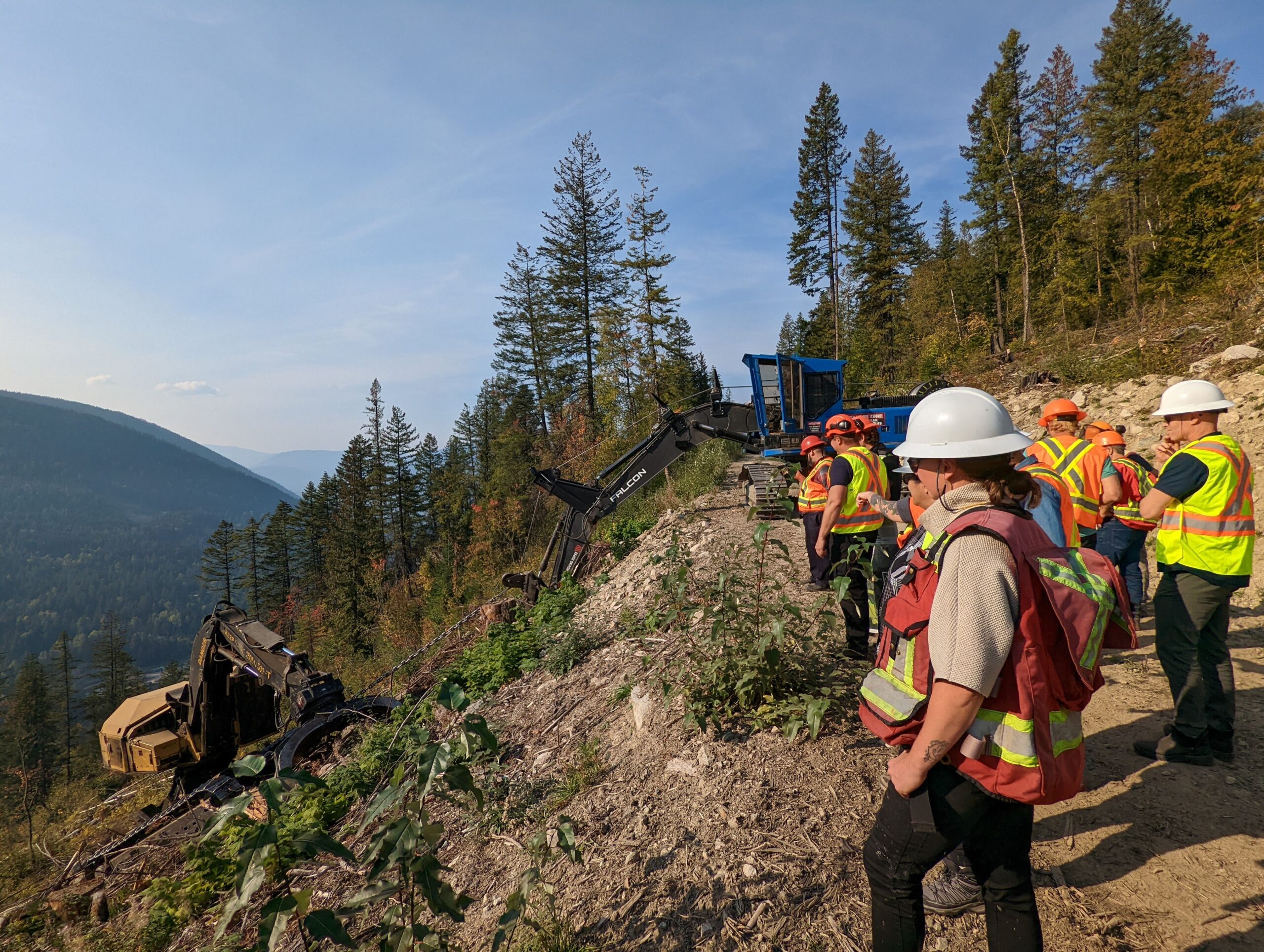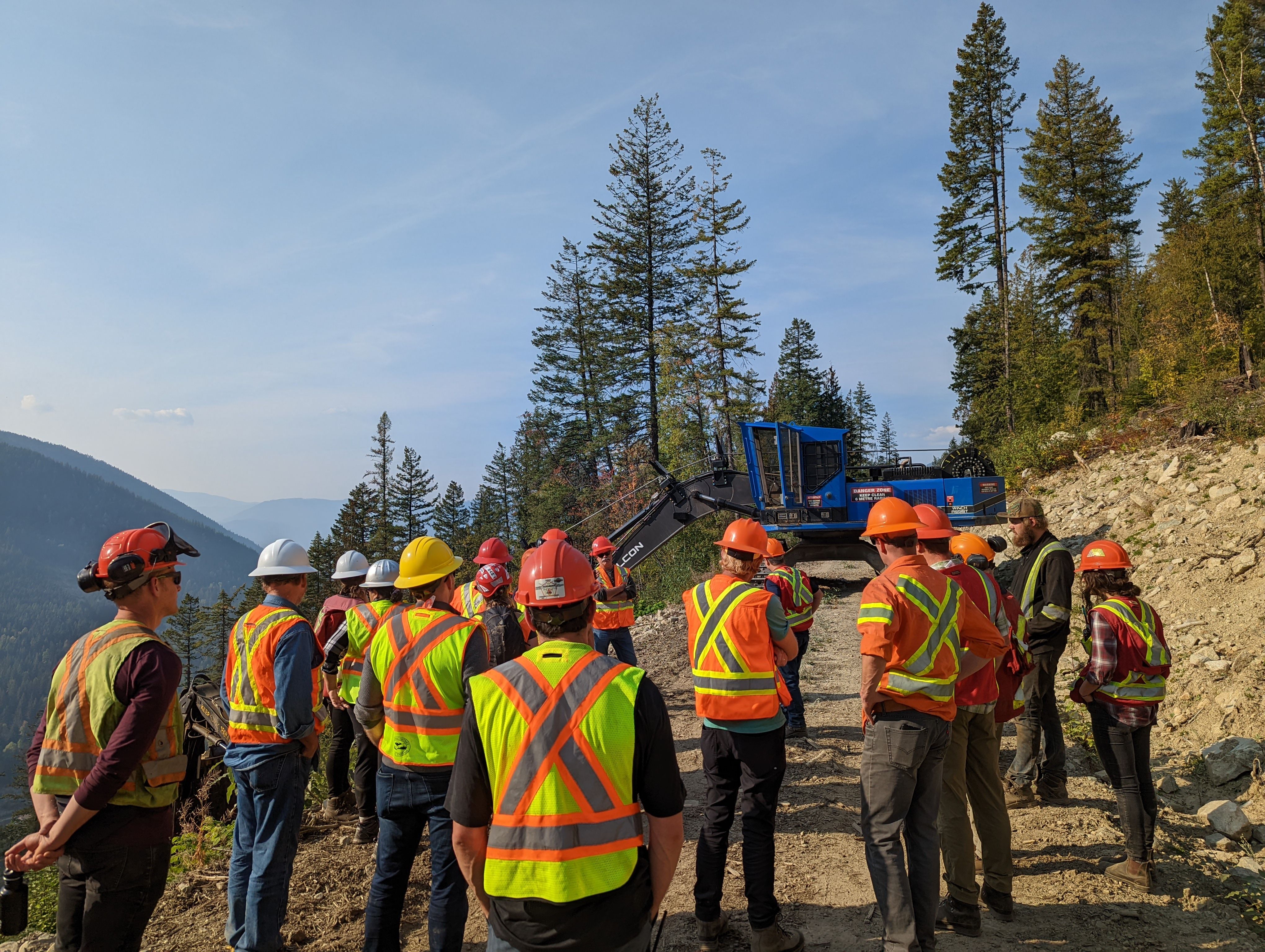Nelson, B.C. – the Selous Creek Wildfire Risk Reduction Project near Nelson, B.C. has demonstrated that it is possible to harvest trees to reduce wildfire risk while maintaining cultural, ecological, recreational, and aesthetic values. With funding from the Forest Enhancement Society of BC (FESBC) and partnerships among regional, municipal and provincial governments, fire services, and a local timber licensee, a wildfire risk reduction project is a prime example of collaboration to better protect a community.
“The Forest Enhancement Society of BC is a proven partner in delivering projects on the ground that benefit communities, workers, and the health of our forests,” said Bruce Ralston, Minister of Forests. “We are building on this foundation with an additional investment of $50 million for the Society to expand funding for projects that increase access to fibre, reduce emissions from slash pile burning and reduce the risk to people from wildfire.”
Row 2 [left photo]: One of the several field tours, [right photo] Fuel loading;
Photo credits: RDCK.
In the last few years, wildfires have threatened and significantly impacted many communities due to their higher intensity and increased severity. With the community of Nelson being identified as strategically important by the Community Wildfire Protection Plan for the city, the Regional District of Central Kootenay (RDCK), with several stakeholders, took steps to reduce the risk of wildfire in the area.
“The Kootenays are a unique place. The area incubates and attracts people with ‘out-of-the-box’ ideas and our elected officials and staff are the proxy of the residents of the RDCK,” said Angela French, RFT, Wildfire Mitigation Supervisor with the RDCK. “The inspiration for our wildfire risk reduction project was the residents’ concerns about wildfire and the risks associated with the changing climate. RDCK Regional Fire Chief Nora Hannon was instrumental in making this program what it is today, and my predecessor Joel Hamilton, continued that legacy.”
Since 2017, the project has made significant strides in its goal to reduce the risk of wildfire. Operating area tenure holder Kalesnikoff Lumber Company (Kalesnikoff) completed 80 hectares of mechanical harvesting or removing trees using machines. Ground-based mechanical fuel modification, or piling additional debris left after harvest, was completed on 20 hectares. Adjacent to the harvested areas and along the Vein bike trail, an additional 5.5 hectares of understory, or layer of vegetation that grows beneath the trees, was treated by hand to thin and remove some of the fuel load. An additional 7.5 hectares of understory hand treatment was completed along the Great Northern Rail Trail. To prepare for the prescribed burn, the project took proactive measures to protect the outer perimeter of the harvested area and surrounding reserve patches by creating a debris-free guard by utilizing a machine-tethered system in areas with steep terrain.
R – L Gerald Cordeiro from Kalesnikoff, Joel Hamilton from RDCK, and Julie Castonguay during an early site visit in June 2019;
Second row [l-r]: L – R Gerald-Kalesnikoff, Troy Petrick-Cathro Consulting, Eric Leslie-consultant, Deb McKillop- Ministry of Forests ecologist, Angela-RDCK; A completed winch-assist fireguard.
Photo credits: RDCK.
Gord Pratt, FESBC Senior Manager said, “FESBC was extremely pleased to provide funding to the RDCK so they could lead the delivery of this project by taking on a role that isn’t common with other Regional Districts across the province. The project was successful due to the collaborative work by all involved and led by the RDCK to ensure meaningful input and involvement in the planning and implementation of the project, which included involving local governments, the Ministry of Forests, the local forest licensee, Kalesnikoff, and local public interest groups. The result was a project that reduced the wildfire risk to people in the Nelson area through diverse forest management activities.”
John Cathro of Cathro Consulting played a major role in the project and applauded the initiative taken by RDCK. “The project would never have happened without the vision and commitment of RDCK staff and elected officials. Everyone involved at the RDCK knew they were doing something innovative, and that success would require taking risks, forming new relationships, and trusting in the process,” said Cathro.
Cathro explained that the project had a few challenges: Building trust and commitment among various stakeholders for a long-term wildfire risk reduction project, limited grant cycles, and shorter attention spans made it difficult to build trust and engage community leaders who could promote the project. Overcoming these obstacles required innovative solutions and a willingness to embrace untested initiatives, and all parties involved showed that in abundance, according to Cathro.
“In the case of climate resilience and community wildfire risk reduction, change is necessary but change does not happen by itself. It takes people to get together and make it happen,” said Cathro, adding, “Given the complexity of the project, FESBC was flexible with changing timelines and modifications to the scope. The project would have stopped after the first year if the funding program was too stringent or unbending.”
Gerald Cordeiro, the Forest Development Manager for Kalesnikoff, also highlighted the collaborative aspects of the project, calling it a success. “One of the main takeaways for me was that the collaboration was a success in terms of advancing our collective knowledge of how to work together on a project in order to achieve the desired results,” said Cordeiro.
According to Cordeiro, the collaboration kicked into high gear when Kalesnikoff, the RDCK, BC Wildfire Service, the City of Nelson, and several notable local experts began investigating and planning for what can now be seen as a mostly-complete fuel treatment on the hillside just south of Nelson. “Throughout the planning process, we kept coming back to the idea that this would be a first-of-its-kind project, and the collaborative aspect was as important as the physical results. We learned to work within a multi-jurisdictional shared decision-making environment that will act as an invaluable model for other future projects. The planning process also included seeking input from other local interest groups, Indigenous communities, and the local community, in addition to engaging with Selkirk College and FP Innovations,” explained Cordeiro.
The project has the prescribed burn left to do this year. Kalesnikoff will also be tree planting and placing pheromone deterrents to keep the bark beetles out of the Douglas Fir trees. “We all want to make sure we take the opportunity to get the message out that collaboration works, and we can now demonstrate significant results to benefit society without an untenable set of compromises,” said Cordeiro.
FESBC would like to gratefully acknowledge the financial support of the Province of British Columbia through the Ministry of Forests.










